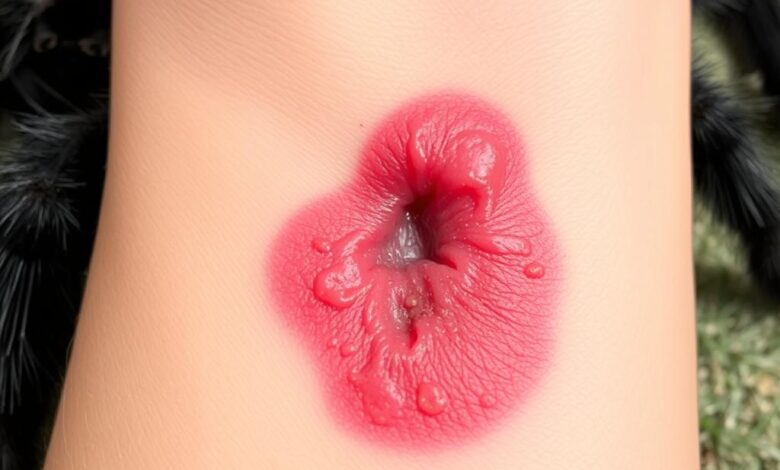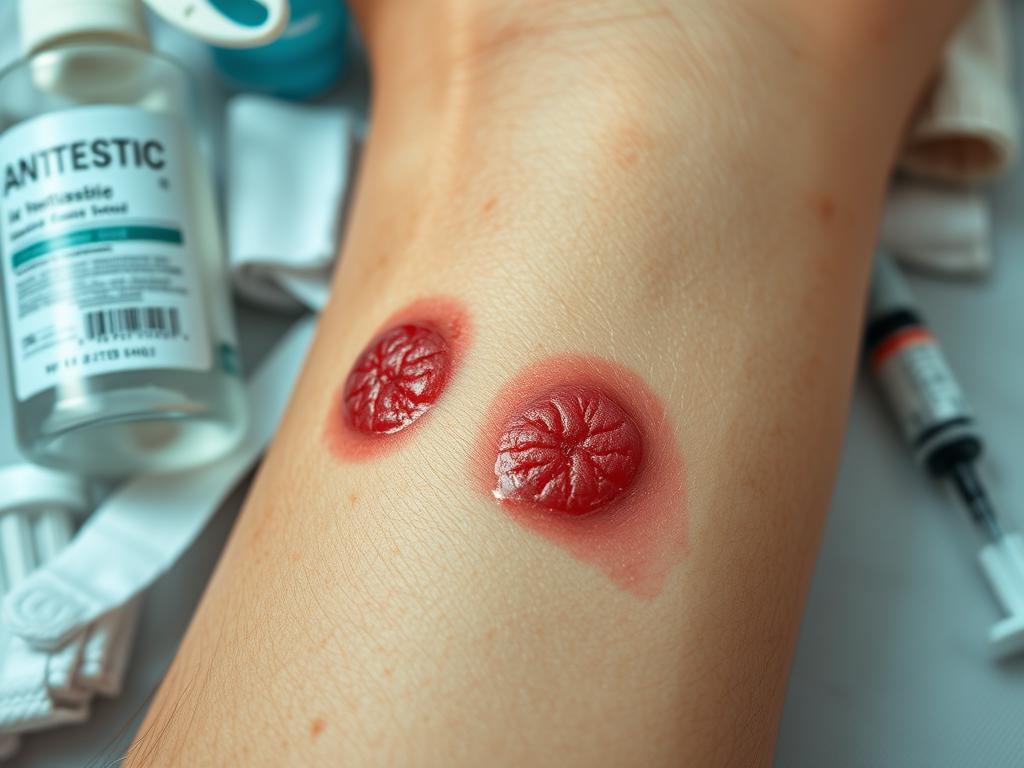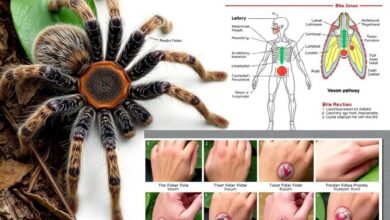Treating Allergic Reactions to Tarantula Bites

Did you know that tarantula bites can cause severe allergic reactions in some people? These big spiders might look harmless, but their venom can be dangerous for those allergic to it. Luckily, with the right knowledge and preparation, you can stay safe. We’ll cover the signs of allergic reactions, first aid steps, and medical treatment options in this article. Knowing the risks and how to prevent them can keep you safe around these interesting spiders.
Understanding Tarantula Bite Allergic Reactions
Tarantula bites can cause allergic reactions, from mild skin issues to severe anaphylaxis. It’s important to know the symptoms to get quick medical help.
Symptoms of Anaphylaxis
Anaphylaxis is a severe allergic reaction that can happen after a tarantula bite. Signs include trouble breathing, swelling of the throat and tongue, and a sudden drop in blood pressure. These signs need quick emergency care to avoid serious problems.
Recognizing Urticaria and Angioedema
Urticaria, or hives, is a common allergic reaction to tarantula bites. It shows as red, itchy welts on the skin. Angioedema is swelling of the skin’s deeper layers, also a common reaction. Both should be watched closely as they can mean a bigger allergic issue.

| Allergic Reaction | Symptoms | Severity |
|---|---|---|
| Anaphylaxis | Difficulty breathing, swelling of throat and tongue, drop in blood pressure | Life-threatening |
| Urticaria (Hives) | Red, itchy welts on the skin | Moderate to severe |
| Angioedema | Swelling of the deeper layers of the skin | Moderate to severe |
Knowing about allergic reactions from tarantula bites is key for quick and right medical care. Spotting symptoms of anaphylaxis, urticaria, and angioedema helps people get help fast and lowers the risk of serious issues.
First Aid for Tarantula Bites
If you or someone you know has been bitten by a tarantula, act fast. Quick action is key to handling the situation and avoiding problems. The steps you take right away can really help.
Start by gently cleaning the bite with soap and water. This removes venom or bacteria from the bite. Don’t scrub or rub hard, as it can make things worse.
Then, put a cold compress or ice pack on the bite. It helps with swelling and pain. Make sure the ice is covered with a thin cloth to protect your skin.
Watch for signs of an allergic reaction, like trouble breathing, swelling, or feeling dizzy. If you see these signs, get medical help right away. They could mean a serious allergic reaction called anaphylaxis.
Don’t try to suck out the venom or use a tourniquet. These actions can actually make things worse. Stay calm, support the person, and take them to a doctor if needed.
By following these first aid steps for a tarantula bite, you can lessen the risk of complications. This ensures the safety and well-being of the person affected.
Tarantula Bite Allergic Reaction
Severe allergic reactions to tarantula bites, known as anaphylaxis, can be very dangerous. They need quick medical help. It’s important to know the signs of this serious reaction to get help fast and avoid bad outcomes.
Identifying Severe Allergic Reactions
Symptoms of a severe allergic reaction to a tarantula bite may include:
- Difficulty breathing or swallowing
- Swelling of the face, throat, or tongue
- Rapid, weak pulse
- Dizziness or confusion
- Pale or clammy skin
- Nausea or vomiting
Monitoring for Hypotension and Shock
Watch for signs of hypotension (low blood pressure) and shock, which are very serious. These signs include:
- Decreased level of consciousness
- Pale, cool, and clammy skin
- Rapid, weak pulse
- Nausea or vomiting
If you see any of these signs, get medical help right away. The person might be having a severe, possibly deadly, allergic reaction. They need quick treatment.
Medical Treatment for Allergic Reactions
Severe allergic reactions to tarantula bites often call for epinephrine, also known as adrenaline. This medicine helps to shrink blood vessels, lessen swelling, and improve breathing. These steps are key to handling the dangerous signs of anaphylaxis.
Doctors may also give antihistamines to fight the histamine response, corticosteroids to lessen swelling, and intravenous fluids to keep fluids and blood pressure stable. This mix of treatments aims to keep the patient stable and stop the allergic reaction from getting worse.
Epinephrine Administration
Epinephrine is the go-to treatment for Tarantula Bite Allergic Reaction and should be given right away. It comes in an auto-injector that makes it easy for the patient or someone nearby to give the shot. It’s important to use it correctly and fast, as it can turn around life-threatening symptoms like trouble breathing and heart issues.
If one dose of epinephrine doesn’t help, more might be needed. People who’ve had a bad reaction to a tarantula bite should be watched closely. They might also be given an epinephrine auto-injector to carry with them for future bites.
Managing Nausea, Abdominal Cramps, and Muscle Spasms
Some people may feel nausea, abdominal cramps, and muscle spasms after a Tarantula Bite Allergic Reaction. These symptoms can be treated with anti-nausea drugs, muscle relaxants, and painkillers. Always follow your doctor’s advice. It’s also key to drink plenty of water and rest.
Your doctor might suggest the following to ease these symptoms:
- Anti-nausea medications to lessen nausea and stop vomiting
- Antispasmodic drugs to ease abdominal muscle spasms and cramps
- Pain relievers to help with muscle spasms and pain
Drinking lots of fluids and resting can help your body heal. These steps can make you feel better faster from a Tarantula Bite Allergic Reaction.
Spider Envenomation and Anaphylaxis
When a tarantula bites, it can inject venom into the body. This can cause a severe allergic reaction called anaphylaxis. This condition is very serious and needs quick medical help. It can lead to breathing problems, heart issues, and even death if not treated right away.
It’s important to know the signs of Tarantula Bite Allergic Reaction. Look out for hives, swelling in the face, and trouble breathing. Other signs include a fast heartbeat and feeling dizzy. If these signs don’t get attention, the situation can get worse, leading to a serious spider envenomation emergency.
| Symptom | Description |
|---|---|
| Hives | Raised, itchy red rash that appears suddenly on the skin |
| Swelling | Rapid swelling of the face, lips, tongue, or throat, making it difficult to breathe |
| Respiratory Distress | Wheezing, coughing, or shortness of breath |
| Rapid Heartbeat | Palpitations or a sense of the heart racing |
| Dizziness | Feeling lightheaded or faint |
If you or someone you know has these symptoms after a Tarantula Bite Allergic Reaction, get help fast. Quick action with epinephrine and other treatments is key. It can save lives in cases of spider envenomation and anaphylaxis.
Prevention and Precautions
To avoid an allergic reaction to a tarantula bite, prevent the bite from happening. Wear protective clothing and keep a safe distance from tarantulas. If you’re allergic to tarantula venom, carry emergency medication and stay away from these spiders.
Avoiding Tarantula Encounters
Be careful around tarantulas to avoid bites and allergic reactions. Learn about their natural habitats and behaviors. Wear gloves and long sleeves when handling them, and move slowly to avoid startling them.
If you’re allergic to tarantula venom, always carry emergency medication. Also, avoid places where you might meet these spiders. Always be aware of your surroundings and talk to a doctor to be ready for any allergic reactions.


